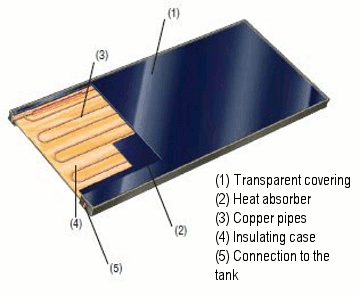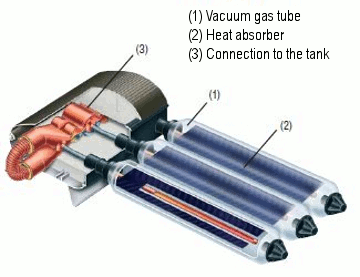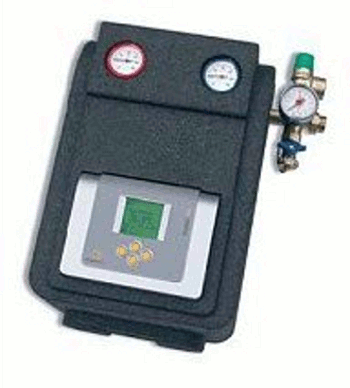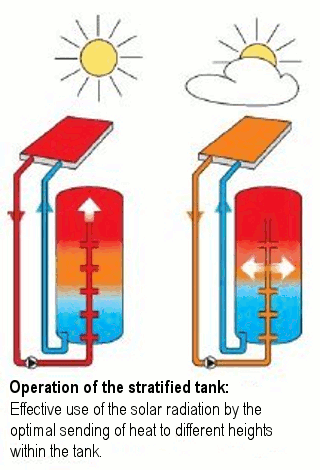Solar Heating Panels and other Components of a Solar Hot Water System
Solar heating components
Flat collector
The frequently used flat collector panels include a housing isolated with a transparent covering of the solar radiation absorber. The absorber is generally a sheeting of dark copper, with a special coating, which absorbs heat and transmits it to a heat transfer fluid. The heated fluid is transported towards the tank by pipes. The cost of manufacture of the flat collectors is relatively low, but they suffer from more heat loss than vacuum collectors. In comparison with vacuum collectors, the same power consumption requires a larger surface of collectors.

Flat Solar Heating Collector Panel
Vacuum tube collectors
In the vacuum tube collectors, the solar heat absorber is integrated in a glass vacuum tube, thus reducing the heat losses. Unlike flat collectors, these tubular collectors retain their effectiveness in the event of strong differences between the temperatures of the collector and the ambient temperature, and they are also appropriate for the production of heat at a high temperature.

Vacuum Tube Collector
Solar regulators
The solar regulator is the essential component: it automates the optimal use of the heat produced in the collector. It includes measurement of the tank temperature and the collector temperature: the solar circuit functions only when the temperature in the collector is higher than that of tank. The installation of a meter to measure the quantity of heat, thus allowing control of the solar installation’s operation, is important, and is necessary to obtain financial State aids in some countries: The heat meter measures the energy supplied by the solar installation in the accumulator.

Solar Regulator
Hot Water Tank
The tank of a solar heating installation stores warm water produced by solar energy. The total output of the installation is determined by the quality of the tank, so good thermo-insulation is vital. The tank also provides warm water during the night and during the days when the radiation of the sun is insufficient for the heating of water. Automatic regulation activates a backup gas, fuel oil or wood powered heating when the radiance of the sun is not strong enough to heat the water. In addition to being connected to the solar collector, the solar tank must thus enable a method of supplementary heating. This is known as a bivalent tank. For this reason, conventional domestic water tanks are not appropriate for use as solar tanks. The laminated solar tanks, of high-quality, work in thermal layers, and allow high outputs: heat coming from the collector is introduced just at the correct thermal level of the stratified solar tank (high temperature at the top, lower at the bottom of the tank).

Solar Hot Water Tank
 Based on a report from The Town of Luxembourg.
Based on a report from The Town of Luxembourg.
Please link to this page.
- Renewable Energy:
- Login to post comments
